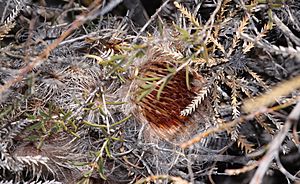Bearded dryandra facts for kids
Quick facts for kids Bearded dryandra |
|
|---|---|
 |
|
| Banksia shuttleworthiana at Alexander Morrison National Park, Western Australia | |
| Scientific classification | |
| Genus: |
Banksia
|
| Species: |
shuttleworthiana
|
| Synonyms | |
|
Dryandra shuttleworthiana Meisn. |
|
The Bearded Dryandra, also known as Banksia shuttleworthiana, is a special type of shrub. It grows low to the ground and spreads out. You can only find it in Western Australia, which means it's endemic there. This plant has thin, fuzzy stems. Its leaves are long and narrow with many deep cuts. It grows creamy brown to purplish flowers in groups of about forty. Later, these flowers turn into a few egg-shaped seed pods.
What it Looks Like
The Bearded Dryandra is a low, spreading shrub. It usually grows up to about 70 centimeters (2.3 feet) tall. This plant has a special woody swelling underground called a lignotuber. This helps it survive fires and grow back.
Its stems are thin and covered in soft, woolly hairs. The leaves are long and narrow, like lines. They are between 30 and 140 millimeters (1.2 to 5.5 inches) long. Each leaf is 4 to 7 millimeters (0.16 to 0.28 inches) wide. They grow on a small stalk called a petiole, which is about 5 millimeters (0.2 inches) long. Each side of the leaves has between fifteen and fifty pointed, triangular parts.
The flowers of the Bearded Dryandra are creamy brown to purplish. They have a strong, musky smell. These flowers grow in groups of 30 to 45. At the bottom of each flower group are thin, hairy leaf-like structures called involucral bracts. These are 30 to 40 millimeters (1.2 to 1.6 inches) long. The flower's outer parts, called the perianth, are 25 to 35 millimeters (1.0 to 1.4 inches) long. The female part of the flower, the pistil, is 24 to 35 millimeters (0.9 to 1.4 inches) long and straight.
This plant flowers from July to September. After flowering, it forms egg-shaped seed pods called follicles. These pods are 16 to 24 millimeters (0.6 to 0.9 inches) long and are covered in hairs. Only a few of these seed pods grow in each flower head.
How it Got its Name
This plant was first officially described in 1855. A scientist named Carl Meissner gave it the name Dryandra shuttleworthiana. He published his description in a science journal called Hooker's Journal of Botany and Kew Garden Miscellany. He studied plant samples collected by another botanist, James Drummond.
Later, in 2007, two scientists named Austin Mast and Kevin Thiele made a change. They moved all plants from the Dryandra group into the Banksia group. So, this plant was renamed Banksia shuttleworthiana.
Where it Lives
The Bearded Dryandra grows in a type of shrubland called kwongan. This area is found in Western Australia. You can find it between the towns of Geraldton and Gingin. It grows in several natural areas, including the Avon Wheatbelt, Geraldton Sandplains, Jarrah Forest, and Swan Coastal Plain. These are special areas known as biogeographic regions.
Is it Protected?
The Western Australian Government's Department of Parks and Wildlife keeps track of plants. They have classified this banksia as "not threatened." This means it is not currently in danger of disappearing.

